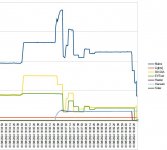wwhitney
Senior Member
- Location
- Berkeley, CA
- Occupation
- Retired
But what is the relevance of the shape of the current waveform over one 60 Hz cycle of 16.7 ms?I was referring more to what carl said in post #19. These are certainly switching power supplies and not a simple rectifier that "chops off" half the wave so their Waveform will be complex.
Cheers, Wayne

